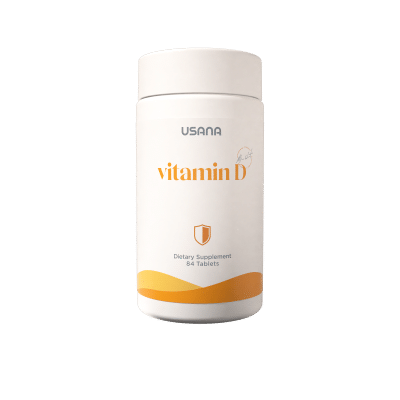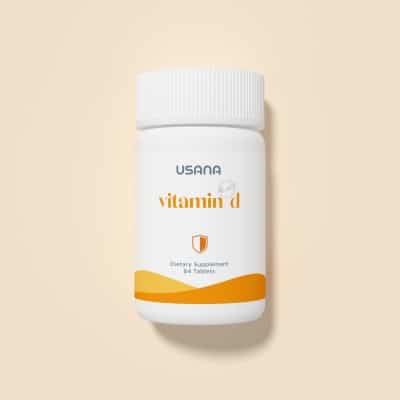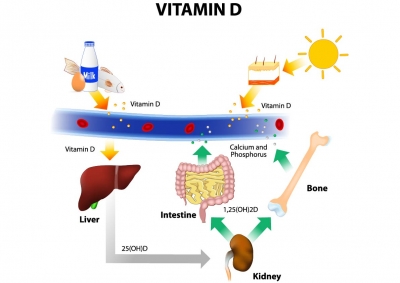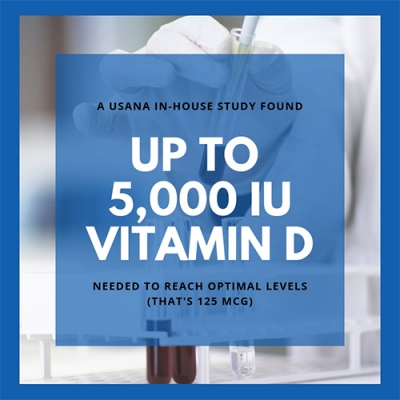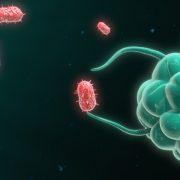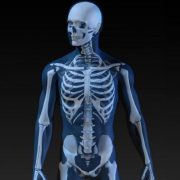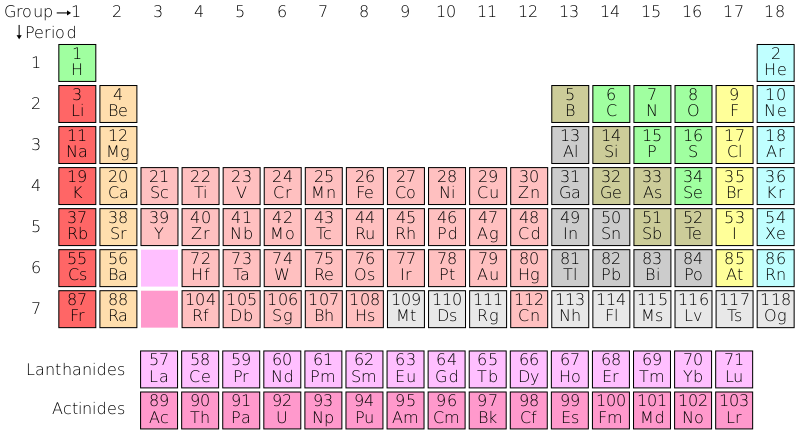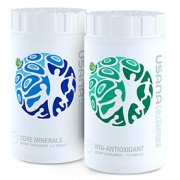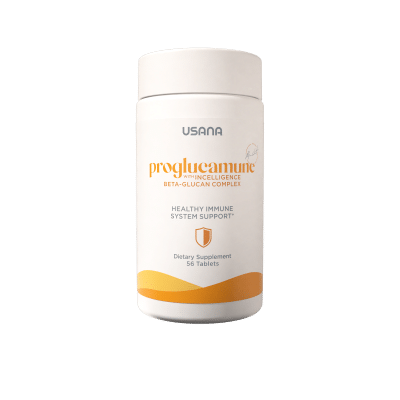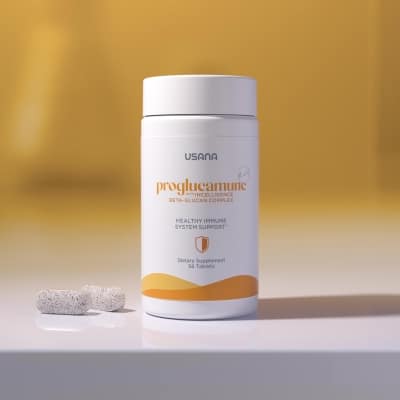The Simple Way to Boost Your Sunshine: USANA Vitamin D
USANA® Vitamin D
Support your daily wellness and a strong, healthy body with a high-potency vitamin D3 supplement that’s also high in vitamin K2.*
Sunshine. It feeds your soul and, quite literally, nourishes your body by helping it create vitamin D. But you have to be committed if you want to get all your vitamin D from the sun. First, make sure you live close enough to the equator during the prime time of year for optimal rays. Then spend at least 10 to 15 minutes outside every couple of days, between 10 am and 3 pm. Expose as much skin as possible. And don’t wear sunscreen but avoid a skin-damaging sunburn.
Sounds complicated, right? You’ve got things to do, places to go, and people to see. So, do yourself a favor—get dressed, slather on your daily sunscreen, and nourish your body by taking USANA® Vitamin D all year.*
The odds are high that you need to supplement your sunshine. You could be one of every two people worldwide who are deficient. And getting enough vitamin D is important. This essential nutrient has been associated with maintaining good health throughout the body in many ways:
- Retaining normal cellular health and function*
- Supporting bone and tooth mineralization and growth*
- Supporting muscle strength and coordination*
- Assisting robust and balanced immune function*
Supplementation with vitamin D has been linked to long-term good health. And USANA’s Vitamin D formula also offers another key benefit for lifelong well-being. It’s especially heart smart because it’s high in vitamin K2, an important nutrient for cardiovascular health.*
If you spend a lot of time outdoors in the sun, you may not need additional vitamin D supplementation beyond your regular multivitamin on most days. But if, like most people, you aren’t getting the right kind of sunlight every day, try to spend more time in nature and make USANA Vitamin D your personal source of sunshine.
A Not-So-Sunny Outlook for Trends in Vitamin D
Vitamin D status is a factor in the maintenance of good health. However, deficiency and insufficiency are all too common. Reports continue to show that nearly 50 percent of the worldwide population is suffering from too little vitamin D. In the U.S. alone, as many as two-thirds of people don’t get enough vitamin D every day.
The problem is widespread and increasing. This could have potentially severe and far-reaching repercussions. Low vitamin D status has been linked to many different poor health outcomes in people across the globe.
There are a number of factors that can contribute to insufficient levels of vitamin D.
Lack of UVB Exposure
Humans evolved outdoors, where we were constantly exposed to sunlight. So, our bodies developed the ability to convert ultraviolet B (UVB) rays into a vital substance that acts like a vitamin and a hormone to support our health: vitamin D.
Unfortunately, the circumstances for UVB exposure aren’t too favorable in the modern world. People spend more and more time indoors. And fears of skin cancer and premature aging mean wearing sunscreen and covering up when outdoors. This has led to a significant decline in natural vitamin D levels due to a lack of UVB exposure.
Where You Live
Take a look at a globe and find the equator. As you get further from it, your body will have a harder time using sunlight to make vitamin D. This is because sunlight is hitting the atmosphere at more of an angle, blocking out more UVB rays, especially during the winter season. If you live in polluted areas, that can impact how much UVB gets through to your skin, too.
Time of Day and Year
During the fall and winter months, the sun’s angle is also a problem. This is because fewer UVB rays pass through the atmosphere during the early and later parts of the day. The closer to midday you are, the more UVB rays your body is getting.
You can test this simply by looking at the length of your shadow when standing outside. If your shadow is longer than you are tall, fewer UVB rays are reaching your body, and you’re not producing as much vitamin D.
Age
The fact that older people usually spend more time indoors due to lowered mobility, impacts vitamin D status. But aging correlates to vitamin D deficiency in a couple of other ways: First, the skin loses its ability to absorb as much vitamin D as you get older. And second, your kidneys slowly become less effective at converting vitamin D from the sun into the form used by your body.
Skin Color
Those with darker skin are at a higher risk for vitamin D deficiency because skin pigment has a direct correlation with how much vitamin D is made by the body. Some research suggests that those with darker skin may need up to 10 times more sun exposure than those with lighter skin to produce a comparable amount of vitamin D.
Excessive Weight
Vitamin D is fat-soluble—meaning that the fat in your body is how you collect and store it. So, if you’re overweight, the excessive amount of fat in your body needs a comparable amount of vitamin D to absorb. So, you’ll need a lot more vitamin D than someone with a lower percentage of body fat.
Gut Problems
Certain gut conditions that cause a lower absorption of fat can also lower your absorption of vitamin D.
You can add vitamin D to your daily diet with some foods. Fatty fish (salmon and trout), milk (dairy, almond, or soy), yogurt, egg yolks, fortified orange juice, and fortified cereals are sources of vitamin D. However, the amount in these foods is pretty low.
It’s tough to get enough sunshine for your body to make vitamin D. And, depending on your habits, your daily diet may not give you enough either. Fortunately, you can overcome the cloudy outlook about vitamin D. Most experts agree, supplements are a smart, safe way to increase your vitamin D.*
Let the Sunshine in All Year ‘Round with USANA Vitamin D
Fifty micrograms (mcg) may not sound like much. But USANA Vitamin D packs the same amount of vitamin D into one small tablet as you would get from drinking more than 14 cups of milk or four servings of salmon per day.*
And USANA’s Vitamin D supplement is a good choice to help avoid deficiency, because it’s an excellent source of the most useful form of vitamin D—cholecalciferol (vitamin D3). Research suggests D3 is better than ergocalciferol (vitamin D2) at raising levels of active vitamin D in the blood. This increase is backed up in a clinical study that was conducted by USANA scientists. The results showed that individuals taking the USANA multivitamins and/or Vitamin D are six times more likely to have vitamin D levels in the optimal range.*
USANA Vitamin D is also enhanced with another nutrient you might be lacking in your daily diet: vitamin K2. It works with vitamin D to ensure proper calcium utilization in the body to support cardiovascular and skeletal health.*
Each tablet contains 30 mcg of vitamin K2 as menaquinone-4 (MK-4) and menaquinone-7 (MK-7). (“Menaquinone” plus the number is simply a way to describe subtypes of vitamin K molecules with slightly different structures.) By providing both types of vitamin K2, you get benefits similar to those from a varied diet.
The MK-4 form of vitamin K comes from animal sources, like butter, liver, and eggs. Your body also naturally synthesizes a small amount of MK-4 from vitamin K1 (which comes from green leafy vegetables).
The MK-7 form of vitamin K comes from fermented foods that tend to be more popular in Asian cultures, such as natto—the Japanese fermented soy food. The MK-7 used in Vitamin D is exceptionally pure and uniquely designed to be identical to active molecules you would find in nature. This helps ensure long-lasting effectiveness.*
Cell Health is One of Many Benefits of Vitamin D
You’ll find Vitamin D in USANA’s Cellular Health category because many tissues and cells in your body have vitamin D receptors. And they all require it to function properly.*
Vitamin D is unique because it goes through a couple different conversions in your body. First, 25(OH)D is made as a result of a reaction between the vitamin D3 from your skin or diet and enzymes in your liver. This form is considered a prohormone, which means it’s a precursor of a hormone that becomes active when it’s metabolized.
When your body needs it, it takes 25(OH)D and converts it to the active form of vitamin D, which is called “calcitriol” or 1α,25(OH)2D3. (To keep things simple, we’ll continue to refer to it as “vitamin D” or “active vitamin D.”)
Your body tightly controls the circulating levels of active vitamin D. But a supplement can help ensure ample 25(OH)D will be available for conversion into the active form when needed. And your body needs a lot. Because the active vitamin D hormones influence many biological activities by sending messages via receptor sites.
Dozens of tissues have vitamin D receptors, including (but not limited to) cells in the following:
- Skin
- Muscles
- Thyroid
- Brain and central nervous system
- Adrenal glands
- Colon
- Prostate
- Breast
Vitamin D has also been estimated to regulate somewhere between 200-300 genes.
The prevalence of vitamin D’s influence throughout the body is likely why it’s been linked to so many health outcomes. Many of these associations are actively being researched to determine the extent of their connection with vitamin D deficiency. But science currently understands that vitamin D unquestionably exerts a significant influence on many body systems. The most researched being your skeletal system.*
Help Your Skeletal System Stay Strong with Vitamin D
When you think healthy bones and teeth, you probably think calcium. It’s well known as the major building block of a strong skeleton. But other nutrients are equally important.
Vitamins D and K are two nutrients that are vital for minimizing age-associated bone loss and maintaining bone mass. So, you’ll need to consume ample amounts throughout your lifetime. Because keeping your skeleton strong and sturdy becomes especially important as you get older to help you stay stable on your feet.*
Vitamin D works by aiding intestinal absorption of calcium and phosphorus. Vitamin K, too, aids the proper use of calcium in the body. It does this by helping to activate osteocalcin, which is a hormone that takes calcium from the blood and binds it to the bones.*
And the sunshine vitamin doesn’t just shuttle calcium into your bones. Vitamin D is also responsible for initiating the process that moves the mineral out of the bone if calcium is absent from the diet and your body needs it.*
Beyond bone health, deficiency in vitamin D has been linked to weakness or limited joint mobility. And muscle recovery after intense workouts has also been shown to benefit from vitamin D. So, the nutrients in USANA Vitamin D may also support healthy muscle and joint function for complete skeletal support.*
Vitamin K2 Cares for Your Cardiovascular Health
Some research has linked sufficient vitamin D levels and heart health. But the vitamin K2 in USANA Vitamin D also plays a role in another important action your heart will love. It activates the matrix Gla protein (MGA) gene. Production of the MGA protein is necessary, because it acts like a “wrong way” sign. As the osteocalcin hormone incorporates calcium into your bones, the MGA protein directs it away from where you don’t want it to go—your soft tissues. This helps support healthy blood vessels for normal blood flow, making vitamin K a key part of maintaining cardiovascular health.*
Vitamin K2 also has been linked to healthy endothelial function, which is also important to cardiovascular health.*
Vitamin D is the Key to Your Immunity
From long summer days to short wintry nights, your life never slows down. And neither does your immune system. USANA Vitamin D can help keep you well, so you can keep up with your life—no matter the season.
Vitamin D supports a healthy, balanced immune system. It works throughout your body to preserve healthy function, including some places you might not think about when you consider immunity, like your skin. The key role vitamin D plays in immune function is regulating and differentiating immune system cells. In other words, it helps to create specialized immune cells.*
Vitamin D also help control immune responses though cellular communication. Receptors for vitamin D are found on most types of immune cells. When vitamin D binds to cellular receptors, it sends messages to help support many different natural responses that can help keep you healthy. Sometimes, those responses can include turning on production of even more active vitamin D to increase levels right where and when it’s needed.*
How Much Vitamin D Do You Need?
Vitamin D supplementation is essential in the winter, when you spend the most time indoors and are covered up from head to toe. But even when the winter months are behind you, it doesn’t mean your body needs less of a good thing. In fact, research has shown that most people don’t get nearly as much vitamin D from sun exposure in the summer as they might think. So, USANA Vitamin D is formulated with a high level of vitamin D to help prevent deficiency throughout the entire year.*
When it comes to vitamin D recommendations, many experts believe the current Daily Recommended Intake (DRI) is significantly out of line with the science. The DRI set by the Food and Nutrition Board for most adults is only 15 mcg (600 IU) per day. However, much higher amounts are almost always needed to achieve optimal concentrations (40-60ng/mL) of 25(OH)D.*
An in-house study conducted at USANA found that supplementation of up to 5,000 IU of vitamin D3 was necessary to reach the optimal level. That’s about 125 mcg per day. This amount lines up with the recommendation made by the Vitamin D Council.*
The Signs of Low Vitamin D
The only way to know your vitamin D status for sure is to get a vitamin D test. But if you’re wondering what low levels of vitamin D might feel like, here are a couple signs to pay attention to:
Feeling Down and Out
Turns out, when you run low on vitamin D, it takes a pretty serious toll on your mood. This is because your brain produces serotonin—a hormone that affects mood—at a higher rate when you’re exposed to sunshine or bright light.
Achy Bones and Joints
People who are unknowingly deficient in vitamin D might complain of low back pain. This could be related to weakened bones. Those with low levels of vitamin D may not absorb calcium and phosphorus efficiently, which, in turn, may impact bone mass.
Muscle cramps, pain, or weakness; fatigue; and hair loss have also been attributed to low levels of vitamin D. If you’re experiencing any of the above symptoms, talk to your doctor and ask for a test to check your vitamin D levels.
This is why USANA’s Vitamin D is designed to complement other USANA supplements, including the CellSentials, MagneCal D, and BiOmega. It’s an easy way to get 50 mcg (2,000 IU) of vitamin D3 per day. Taking a combination of these USANA products should be enough for most healthy adults to reach ideal levels and get the true health benefits of a vitamin D supplement.
Also, by taking both the CellSentials and the Vitamin D supplement daily, you’ll get a total of 570 mcg of vitamin K—90 mcg of which is vitamin K2. (There is 480 mcg of vitamin K1 in Vita Antioxidant to support blood clotting in addition to bone health).*
Usage
Take one (1) tablet daily, preferably with food.
Keep out of reach of children. Consult your physician if you are pregnant, nursing, taking a prescription drug, or have a medical condition. If you exceed the established Upper Limit (UL) of 100 mcg (4,000 IU/d) for Vitamin D intake, regular blood tests for vitamin D and calcium status are recommended.
Ideal For
- Healthy adults
- Adults who are overweight or obese (more likely to be deficient)
- People who regularly wear sunscreen or spend most of their time indoors
- Certified Kosher (U.S. formula)
Frequently Asked Questions About USANA Vitamin D
Can I take more than one Vitamin D tablet per day?
USANA can only recommend that you follow the suggested serving size and other applicable directions as they are listed on product labels. If you feel that you require higher amounts of vitamin D, please consult with your healthcare professional.
Why does USANA’s Vitamin D contain a warning about blood tests?
USANA’s Vitamin D product provides the following warning on its label:
“Keep out of reach of children. Consult your physician if you are pregnant, nursing, taking a prescription drug, or have a medical condition. If you exceed the established Upper Limit (UL) of 100 µg (4,000 IU/d) for vitamin D intake, regular blood tests for vitamin D and calcium status are recommended.”
In addition to the standard dietary supplement warning, the warning about blood tests is a general warning added as a precaution. There has never been a clinically documented case of vitamin D toxicity below 30,000 IU. However, the official upper limit for vitamin D is currently set at 100 µg (4,000 IU) per day, and as a company we feel it is our duty to promote awareness and education among our customers.
Unfortunately, there are many people who may take dietary supplements without thought of excess or who may not wish to follow label directions. We have included this additional warning because while vitamin D deficiencies are widespread, vitamin D products are not something that should be taken without regard to safety.
If someone has concern about safety, is regularly exposed to unusual levels of sunlight, or wants to be absolutely certain of their vitamin D blood levels, we suggest getting vitamin D levels checked before taking large supplemental levels of vitamin D.
Are there any drug interactions with vitamin D?
Vitamin D supplements do have the potential to interact with certain types of medications (including steroids and cholesterol-lowering drugs). Those taking medications should discuss vitamin D supplementation with their healthcare providers prior to use.
How do I convert micrograms to IU’s?
1 microgram (μg) vitamin D = 40 IU vitamin D
e.g. 50 mcg vitamin D = 2,000 IU vitamin D
References
Nair R, Maseeh A. 2012. Vitamin D: The “sunshine” vitamin. J Pharmacol Pharmacother 3(2): 118-126.
Vitamin D Council. https://www.vitamindcouncil.org/about-vitamin-d/how-do-i-get-the-vitamin-d-my-body-needs/
Vitamin D (Calcitriol). Vivo Pathophysiology [Internet] [accessed 25 July 2018] Available at http://www.vivo.colostate.edu/hbooks/pathphys/endocrine/otherendo/vitamind.html
Palermo A, et al. 2017. Vitamin K and osteoporosis: Myth or reality? Metabolism 70: 57-71.
Wimalawansa SJ. 2012. Vitamin D in the new millennium. Curr Osteoporos Rep 10(1): 4-15.
Aranow C. 2011. Vitamin D and the immune system. J Investig Med 59(6): 881-6.
You May Also Enjoy
The Immune System: Your Body’s Guards
A healthy, functional immune system is a complex machine. It contains many layers, subsystems, tissues, organs, and processes.
Bone Health: Understanding Bone Anatomy
Your bone anatomy makes your skeleton more than your body’s framework. Learn about your skeletal system and how you can support your bone health.
From A to K: Your Complete Vitamin Guide
An introduction to the basics of vitamins and how they help your health. Discover more about the vitamins your body needs.
*These statements have not been evaluated by the Food & Drug Administration. This product is not intended to diagnose, treat, cure, or prevent any disease.


